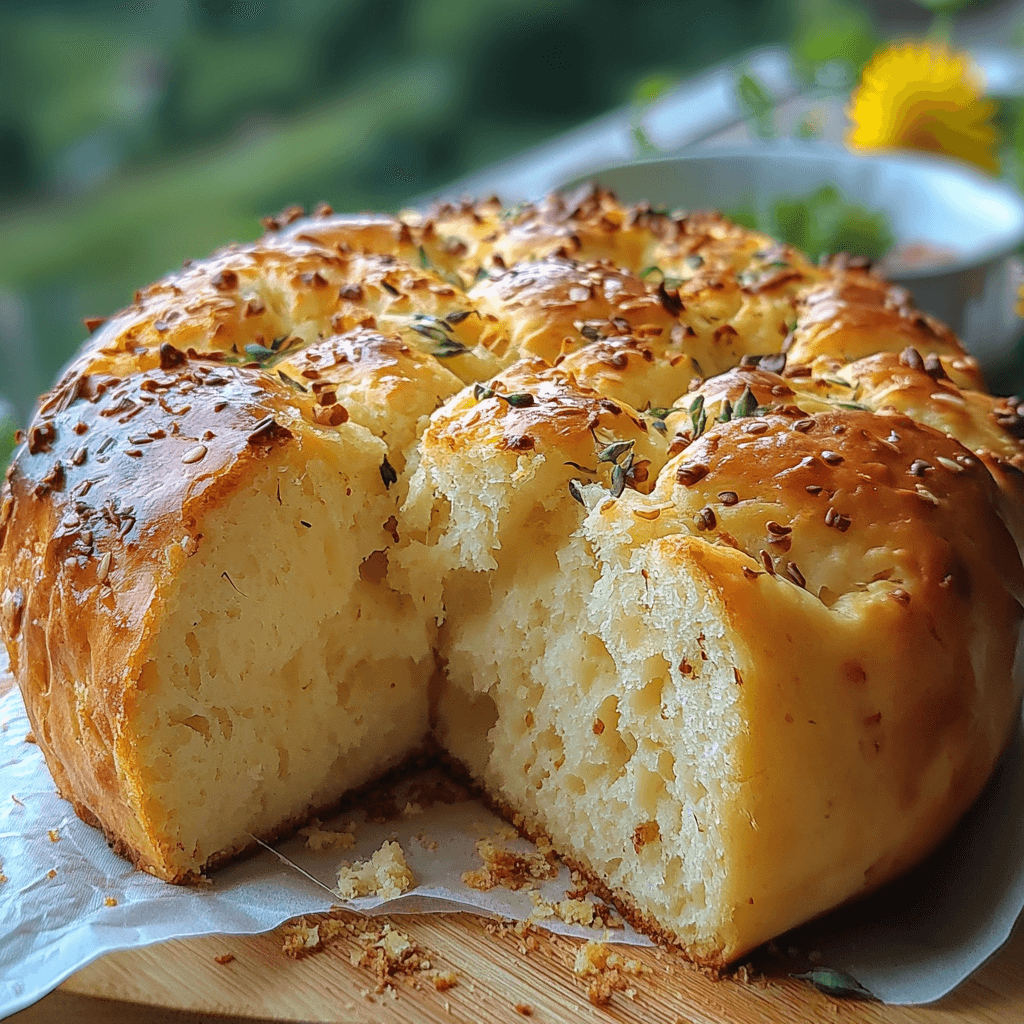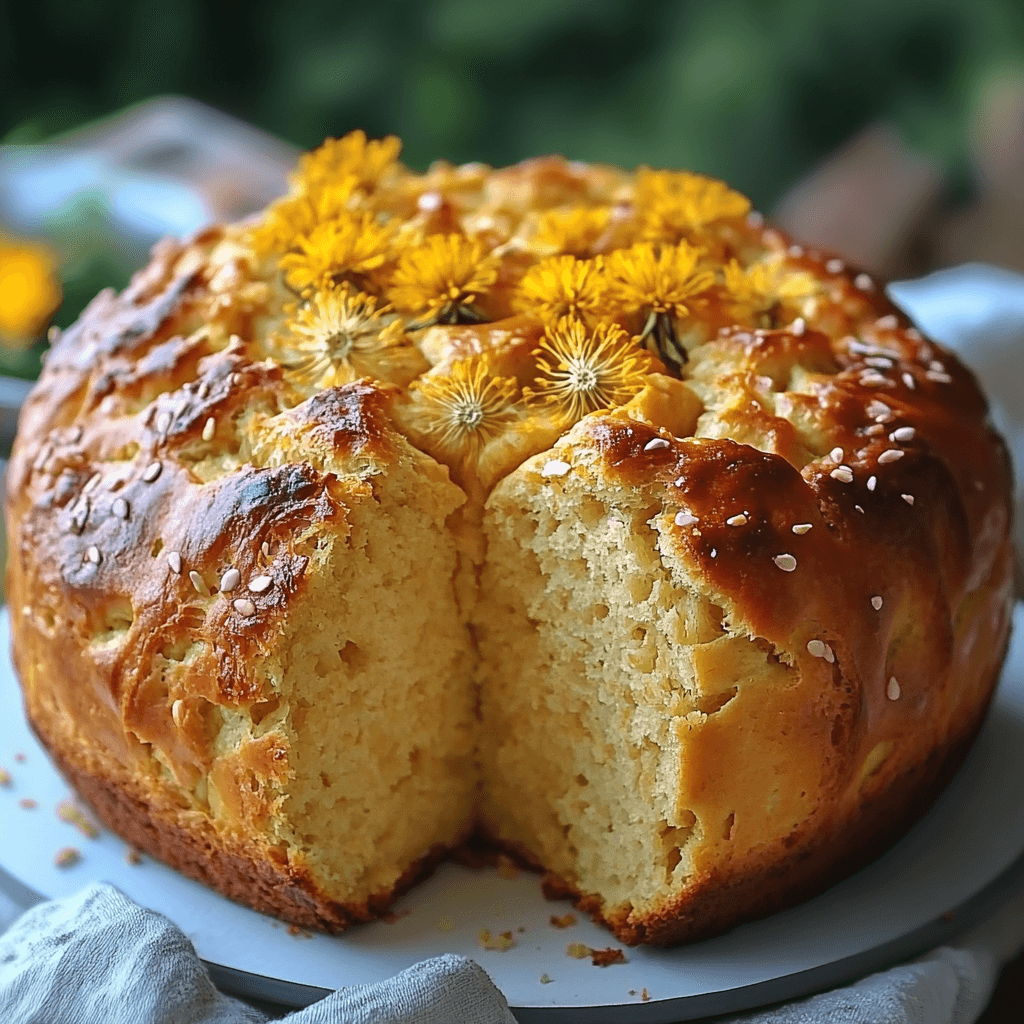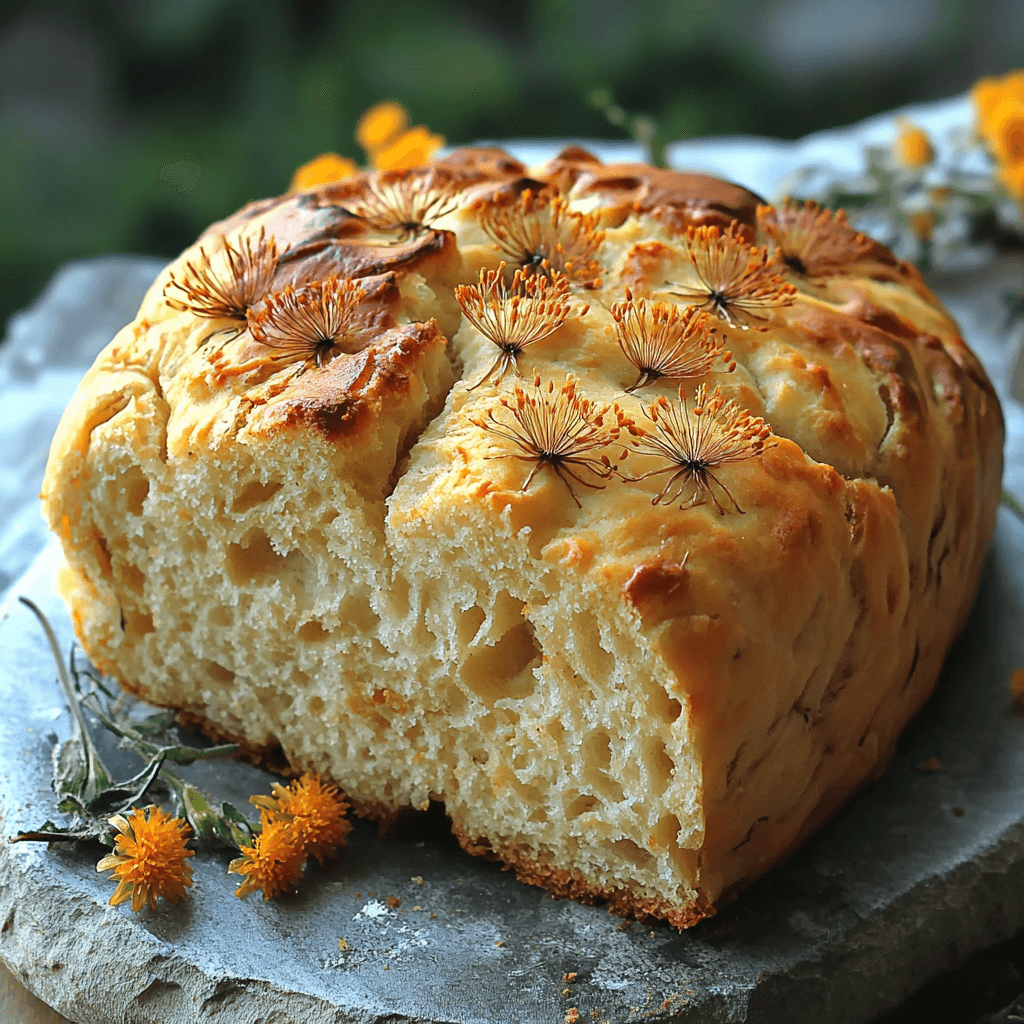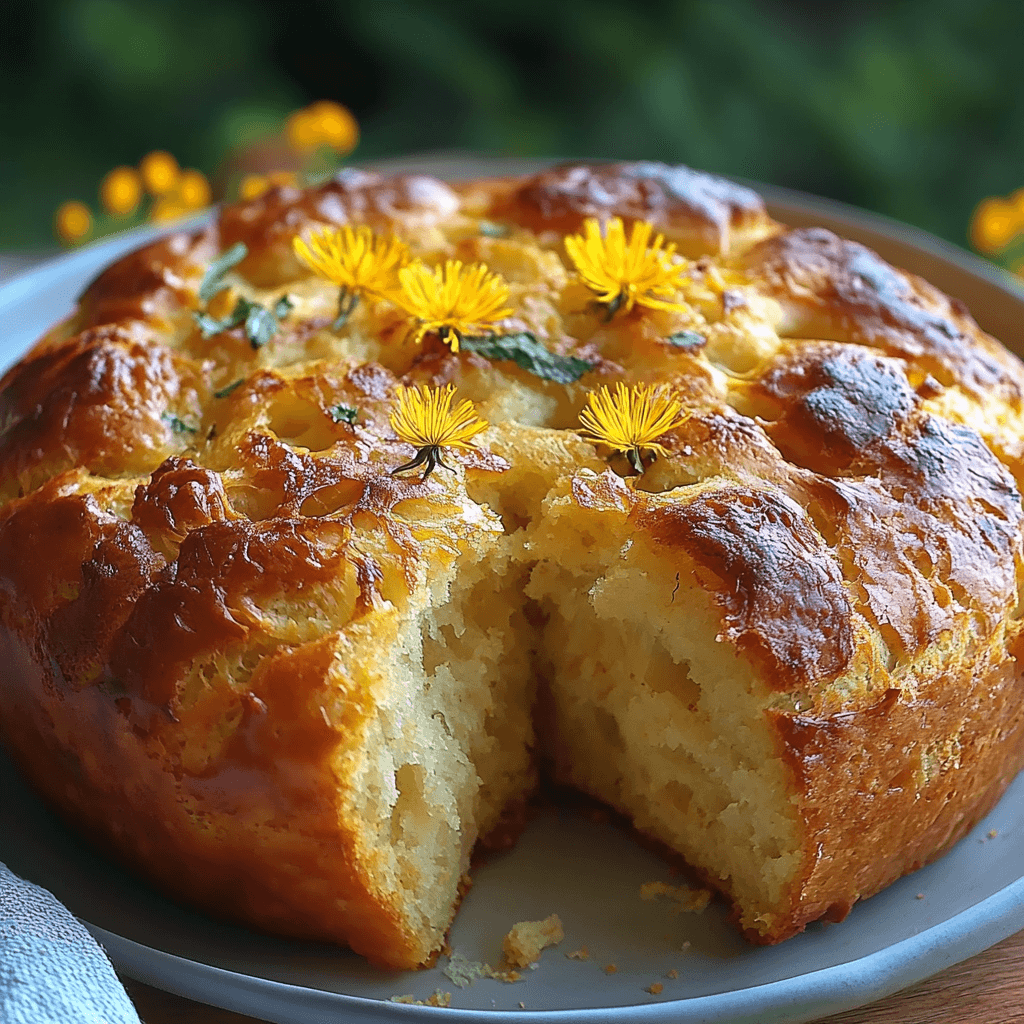If you’re seeking a unique and nutritious twist on traditional bread, look no further than dandelion bread. This delightful recipe not only incorporates the often-overlooked dandelion greens, but it also harnesses their vibrant flavors and health benefits, making it an intriguing choice for adventurous home bakers. The soft loaf is surprisingly versatile, able to be sweetened with honey and nuts, or made savory with herbs and cheese.
Experiment with different flours such as whole wheat or spelt, or add herbs like rosemary or thyme for an aromatic upgrade. For those who prefer a gluten-free option, substitute with almond or coconut flour while adjusting the liquid accordingly. To achieve the ideal texture and rise, ensure your baking powder is fresh and don’t skip the kneading stage, which helps develop the bread’s structure.
Get ready to impress your family and friends with this comforting, earthy loaf that celebrates the often underestimated dandelion—a true gift of nature right in your backyard!
Ingredients for Dandelion Bread:
This delightful and nutritious dandelion bread recipe is perfect for gatherings, serving 8–10 people. Gather the following ingredients to create a unique and exquisite loaf that not only celebrates the flavors of dandelions but also promotes the use of foraged ingredients.

Dry Ingredients:
- 2 cups all-purpose flour
- 1 cup whole wheat flour
- 1 teaspoon baking powder
- 1 teaspoon baking soda
- 1 teaspoon salt
- 1 tablespoon sugar or honey (optional for a touch of sweetness)
Wet Ingredients:
- 1 cup dandelion greens, finely chopped (make sure to rinse them thoroughly)
- 1 cup buttermilk (or substitute with plain yogurt mixed with milk)
- 1 large egg
- 1/4 cup melted butter (can also use olive oil for a lighter option)
- 1 teaspoon vanilla extract (optional for added flavor)
Optional Mix-ins:
- 1/2 cup shredded cheese (such as cheddar or mozzarella for a savory twist)
- 1/4 cup chopped nuts (walnuts or pecans for a crunchy texture)
- 1/2 cup dried fruits (like cranberries or raisins for a hint of sweetness)
- 1 tablespoon fresh herbs (such as rosemary or thyme for increased flavor)
For a Vegan Version:
- Use flaxseed meal mixed with water (1 tablespoon flaxseed meal + 2.5 tablespoons water) as a substitute for the egg
- Substitute buttermilk with a plant-based milk mixed with vinegar (1 cup almond milk + 1 tablespoon vinegar)
- Replace butter with coconut oil or a plant-based butter alternative
Feel free to tweak this recipe by incorporating additional spices like garlic powder or paprika for a flavorful twist. The beauty of this dandelion bread lies in its versatility and the unique character brought by the foraged greens. Enjoy experimenting!
How to prepare Dandelion Bread:
Follow these steps carefully to create a delightful Dandelion Bread from scratch.
Gather Your Ingredients
Begin by sourcing the ingredients you will need:
- 2 cups all-purpose flour
- 1 cup dandelion greens, chopped
- 1 tablespoon baking powder
- 1 teaspoon salt
- 1 tablespoon sugar
- 1 cup milk
- 1 large egg
- 1/4 cup melted butter or oil
Prepare the Dandelion Greens
Next, rinse the dandelion greens thoroughly under cool water. This helps remove dirt and debris.
After washing, chop the dandelion greens into small pieces, ensuring they are ready to mix into the dough.
Combine Dry Ingredients
In a large mixing bowl, combine the all-purpose flour, baking powder, salt, and sugar. Mix these ingredients together thoroughly.
Add the Dandelion Greens
Gently fold the chopped dandelion greens into the dry mixture. This helps distribute the greens evenly throughout the dry ingredients.
Mix Wet Ingredients
In a separate bowl, combine the milk, egg, and melted butter. Whisk these wet ingredients together until they form a homogenous mixture.
Combine Wet and Dry Mixtures
Gradually pour the wet mixture into the bowl containing the dry ingredients. Stir the mixture gently until just combined to avoid over-mixing.
Prepare the Baking Pan
Preheat your oven to 350°F (175°C). Meanwhile, grease an 8-inch loaf pan with butter or oil to prevent the bread from sticking.
Pour the Batter into the Pan
Once combined, transfer the batter into the prepared loaf pan. Use a spatula to smooth the top evenly.
Bake the Dandelion Bread
Place the loaf pan in the preheated oven and bake for 30-35 minutes. The bread is ready when the top is golden brown and a toothpick inserted in the center comes out clean.
Cool and Serve
After baking, remove the pan from the oven and allow it to cool for about 10 minutes. Then, transfer the bread to a wire rack to cool completely before slicing.
Enjoy your homemade Dandelion Bread!

Tips for the Perfect Dandelion Bread
Maintain the Right Temperature
To achieve the best results with your Dandelion Bread, be mindful of temperature. Yeast works optimally at warm temperatures. Aim for a range of 110°F to 115°F when activating yeast. If your liquid is too hot, it can kill the yeast, halting the rising process. Conversely, if it’s too cold, the yeast will not activate properly. Test your liquid with a thermometer or your wrist; it should feel warm, not hot.
During baking, an oven temperature of 375°F usually yields a nice, golden crust. To help your bread rise better, consider placing the dough in a slightly warm oven (turned off) for the first rise. This creates a cozy environment for the yeast to thrive.
Choose Quality Ingredients
Using fresh, quality ingredients makes a noticeable difference. Opt for organic dandelion greens whenever possible. They should be vibrant in color and free from blemishes. Fresh dandelions will impart a more robust flavor and nutritional benefits. Additionally, ensure your flour is also fresh and stored properly to prevent any rancid flavors. Whole grain flour can add texture and nutrition, but all-purpose flour makes for a lighter bread if desired.
Don’t forget about the salt. Salt adds flavor and helps control yeast activity, leading to a better rise and texture. Always use fine sea salt or kosher salt for the best taste and results.
Substitutions for Dietary Restrictions
If you have dietary restrictions, numerous substitutions are available without sacrificing flavor. For a gluten-free option, substitute all-purpose flour with a gluten-free blend. These blends often contain xanthan gum, which aids in binding and structure.
For those sensitive to dairy, you can replace milk with almond milk or oat milk. If you’re vegan, substitute eggs with flaxseed meal mixed with water. Mix one tablespoon of flaxseed meal with two and a half tablespoons of water and let it sit for five minutes to form a gel before adding it to the mixture.
Enhancing Flavor with Variations
Feel free to experiment with additional herbs and spices to elevate your Dandelion Bread. Adding garlic powder or a sprinkle of nutritional yeast can enhance the flavor profile. You can also fold in nuts or seeds for added crunch and nutrition. Think about incorporating chopped walnuts or sunflower seeds for a delightful surprise in every bite.
Remember, making bread is an art and a science. Don’t be afraid to play around with the formula until you perfect your own version of this unique recipe.
Storage Tips for Dandelion Bread:
Storing your freshly baked dandelion bread properly keeps it tasty and prolongs its shelf life. Follow these essential tips to ensure your bread remains delicious for as long as possible.
Maintain Freshness with Immediate Storage
After baking, allow your dandelion bread to cool completely on a wire rack. This cooling process prevents moisture buildup, which can lead to soggy bread. Once cooled, you can choose to slice the bread or keep it whole for storage. Slicing helps with portion control but may expose more surface area to air, potentially speeding up staleness.
Optimal Storage Conditions
Store your bread in a cool, dry place. Use an airtight container, a resealable plastic bag, or wrap it tightly in aluminum foil. These methods block excess air and moisture. You can also use a bread box to maintain the right environment. Avoid storing bread in the refrigerator, as this can cause it to stale faster due to moisture loss.
Freezing Dandelion Bread for Long-Term Preservation
If you receive or want to prepare a large batch, freezing is an excellent option. Slice the bread before freezing so you can easily take out individual pieces. Wrap each slice in plastic wrap, then place them in a freezer-safe bag or container. This method helps prevent freezer burn. Dandelion bread can last up to three months in the freezer. When you’re ready to enjoy a slice, just remove it from the freezer and toast or warm it in the oven.
How to Revive Stale Bread
If your bread does happen to go stale, you can bring back some of its original texture. Moisten the exterior slightly with water and place it in a preheated oven at 350°F (175°C) for about 10 to 15 minutes. This process rejuvenates the crust and makes the inside soft again. Check frequently to avoid over-drying.
Tracking Shelf Life
Fresh dandelion bread typically stays good at room temperature for 3 to 5 days. Proper storage helps maintain its flavor and texture. Always trust your senses. If you notice any mildew or an off smell, it’s best to discard the bread for safety.
By following these storage tips, you can enjoy your dandelion bread at its best, whether you eat it right away or save it for later!
Related Recipes
Dandelion Bread offers a unique taste and a connection to nature. If you enjoy making this wholesome bread, you might also appreciate other recipes that feature foraged or garden ingredients. Here are some options that complement its flavors and spirit.
One excellent choice is Nettle Soup. Just like dandelions, nettles are often found in gardens and parks. Nettle soup is nutritious and easy to prepare. It highlights the fresh, green taste of foraged plants, making it a hearty companion to your bread.
Another recipe to consider is Herb Focaccia. This bread is infused with various herbs, such as rosemary and thyme. The fragrant aroma works well with the earthy notes of dandelion bread. You can enjoy both loaves together, perhaps with a simple olive oil dip.
If you want something sweet to complement your savory bread, try Honey Lavender Biscuits. These biscuits bring a floral essence that echoes the subtle bitterness of dandelion. Their light texture and sweetness balance the more robust flavors of your bread.
Lastly, consider preparing a Wild Green Salad. Using dandelion greens, chickweed, or other edible plants, this salad can accompany your bread beautifully. The freshness and crunch of the greens enhance the overall meal, creating a delightful contrast.
Each of these recipes shares a connection to nature and emphasizes the joy of using fresh, often overlooked ingredients. Enjoy exploring these flavors alongside your dandelion creation!

Frequently Asked Questions:
What is Dandelion Bread made from?
Dandelion Bread is primarily crafted from fresh dandelion greens, flour, salt, and baking powder. The inclusion of wild dandelion leaves not only adds a unique flavor but also contributes nutritional benefits, such as vitamins A, C, and K. Some recipes might incorporate additional ingredients like herbs, garlic, or alternative flours to enhance the taste and texture.
Can I use dried dandelion leaves for this bread?
While fresh dandelion greens yield the best flavor and texture in baking, you can experiment with dried dandelion leaves. Be sure to rehydrate them before using, as they will provide a different consistency compared to their fresh counterparts. However, expect the flavor to be slightly less vibrant when using dried options.
Is Dandelion Bread gluten-free?
Traditional Dandelion Bread recipes are not gluten-free due to the use of regular wheat flour. However, you can modify the recipe by substituting wheat flour with gluten-free alternatives, such as almond flour or a gluten-free all-purpose blend. This allows those with gluten sensitivities to enjoy a delightful loaf inspired by this wild green.
How does Dandelion Bread taste?
The taste of this unique bread tends to be earthy and somewhat nutty, complemented by a slight bitterness from the dandelion greens. The bitterness mellows during baking, and depending on additional ingredients used, your loaf may have hints of herbaceousness or savory notes which create a delightful balance.
What are the health benefits of consuming Dandelion Bread?
Incorporating this wild green bread into your diet can provide several health benefits. Dandelion leaves are rich in antioxidants and essential vitamins, promoting overall wellness. They are known for their potential anti-inflammatory properties and may support digestion and liver function, making this bread both delicious and nutritious.
How can I store leftover Dandelion Bread?
To maintain the freshness of your dandelion-inspired loaf, store it in an airtight container at room temperature for up to two days. If you want to keep it longer, consider refrigerating it, where it should last for about a week. For extended storage, you can slice the bread and freeze it, allowing you to enjoy this unique treat whenever you desire.
Conclusion:
Dandelion bread is a delightful and adaptable recipe that showcases the charm of foraged ingredients. Its straightforward preparation allows even novice bakers to enjoy the process of creating something unique and wholesome. Whether you choose to enhance the flavor with herbs or incorporate different flours, this bread caters to your personal taste and dietary needs. The dandelion greens not only add nutrition but also introduce a subtly earthy flavor that pairs beautifully with various spreads. Remember, exploring flavor combinations is part of the fun! Serve it fresh or toast it for an extra crunch, and don’t hesitate to experiment with toppings and add-ins like nuts or seeds. This recipe embodies simplicity and creativity, making it a perfect choice for healthy eaters and adventurous cooks alike. Embrace the opportunity to craft your version of dandelion bread, and savor the taste of nature in every bite!

